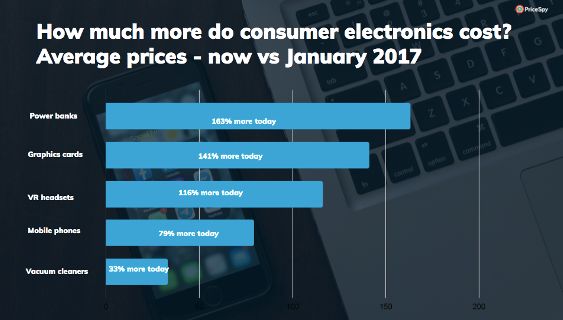Kiwis Are Paying Significantly More For Consumer Electronics Compared To Five Years Ago
If fuel, rent and food price increases weren’t enough, new insights released from the fully impartial price and product comparison site, PriceSpy, reveals Kiwi consumers may also be paying through-the-roof prices for consumer electronics in comparison to 2017*.
The latest research examined price points across a range of consumer electronic shopping categories, comparing average prices now to five years ago. Shockingly, the results revealed:
- The average price across the most-popular graphics cards cost +$856 more today compared to five years ago (an increase of +141 per cent)*;
- The average price across the most-popular VR headsets cost +$581 more today compared to five years ago (an increase of +116 per cent) *;
- The average price across the most-popular mobile phones cost +$528 more today compared to five years ago (an increase or +75 per cent) *;
- The average price across the most-popular power banks cost +$114 more today compared to five years ago (an increase or +163 per cent) *;
But it’s not all doom and gloom – PriceSpy’s research also found the following shopping categories were dropping in price, suggesting now might be a good time for consumers to buy:
- The average price across the most-popular headphones cost -$58 less today compared to five years ago (a drop increase or -13 per cent) *;
- The average price across the most-popular smart home transmitters cost -$19 less today compared to five years ago (a drop increase or -27 per cent) *;
- The average price across the most-popular Nintendo Switch games cost -$19 less today compared to five years ago (a drop increase or -27 per cent) *;

Liisa Matinvesi-Bassett, New Zealand country manager for PriceSpy, says: “According to our latest research, across the last five years there have been significant price hikes happening across consumer electronic shopping categories.
“One of the biggest price hike examples found was for graphics cards - with the average price across the most-popular products now costing +$854 more today compared to five years ago (an increase of +141 per cent).
“Similarly, the average price across the most-popular VR headsets costs +$581 more today compared to five years ago (an increase of +116 per cent) and for power banks, the difference was +$114, up +163per cent compared to five years ago.”
“There are many factors affecting how much consumer electronics cost - and one of the ongoing impacts is, of course, Covid-19, says Liisa.
“The cost of manufacturing has risen, as businesses continue to be hard-hit by ongoing staff sickness, issues with supply chains, stock and component shortages, increased consumer demand and heightened shipping costs. All of these elements will impact how much a product is sold to the consumer for.
“With inflation rates currently sitting at a 30-year high in New Zealand, the price of goods and services can become more expensive. Margins for businesses get squeezed and essentially, price rises get passed back on to consumers.
"Finally, another reason price points across consumer electronics are going up is product innovation and technological advances.”
Liisa continues: “A prime example of this is in the offering of 5G for mobile phones. For instance, when we look at what the average price was across the most-popular mobile phones in January 2017, it was just $528. Whereas now it’s $947 - a significant increase of +79 per cent.
“Similarly, when we look at another popular shopping category, such as cordless vacuum cleaners, price points across the last five years have also risen - jumping from $516 in January 2017 to $685 today (up 39 per cent).
“Essentially, the more capabilities a product offers, coupled with better technology and features, the more it costs to make and the more a consumer can expect to pay**.”
Despite the PriceSpy research finding average price points across many tech-related shopping categories were increasing, some did appear to be dropping.
Liisa comments: “The good news is not all consumer electronics are more expensive to buy right now, which will hopefully offer some welcomed relief to consumers.”
The PriceSpy research revealed the average price across the most-popular headphones appeared to be falling. In 2017, the average price was $454, whereas now it’s $411 - offering a nine per cent saving.
Liisa concludes: “With so many factors affecting the price of goods right now, conducting price research before couldn’t be more important.
“As well as providing shoppers a platform to seek out the best deals and prices, price comparison sites and apps, like PriceSpy, offer consumers the opportunity to look at how much a product has sold for historically.
“Such information helps consumers make more-informed purchase decisions, as they can see whether the price of the item they are looking to buy is increasing or decreasing over time. Essentially, this means they can work out whether today’s price actually worth buying at.
“Shopping around and conducting pricing research is quick, free and easy to do so. Download the PriceSpy app today.”


 NZ Airports Association: Airlines And Airports Back Visa Simplification
NZ Airports Association: Airlines And Airports Back Visa Simplification Netsafe: Statement From Netsafe About Proposed Social Media Ban
Netsafe: Statement From Netsafe About Proposed Social Media Ban The Reserve Bank of New Zealand: 2024 General Insurance Stress Test Results Published Today
The Reserve Bank of New Zealand: 2024 General Insurance Stress Test Results Published Today  Worldline: School Holidays And Long Weekends Change Regional Spending Patterns In April
Worldline: School Holidays And Long Weekends Change Regional Spending Patterns In April Stats NZ: Livestock Numbers Fall Over The Last 10 Years While Area Planted In Fruit Increases
Stats NZ: Livestock Numbers Fall Over The Last 10 Years While Area Planted In Fruit Increases Moths and Butterflies NZ Trust: Tagged Monarchs Found
Moths and Butterflies NZ Trust: Tagged Monarchs Found